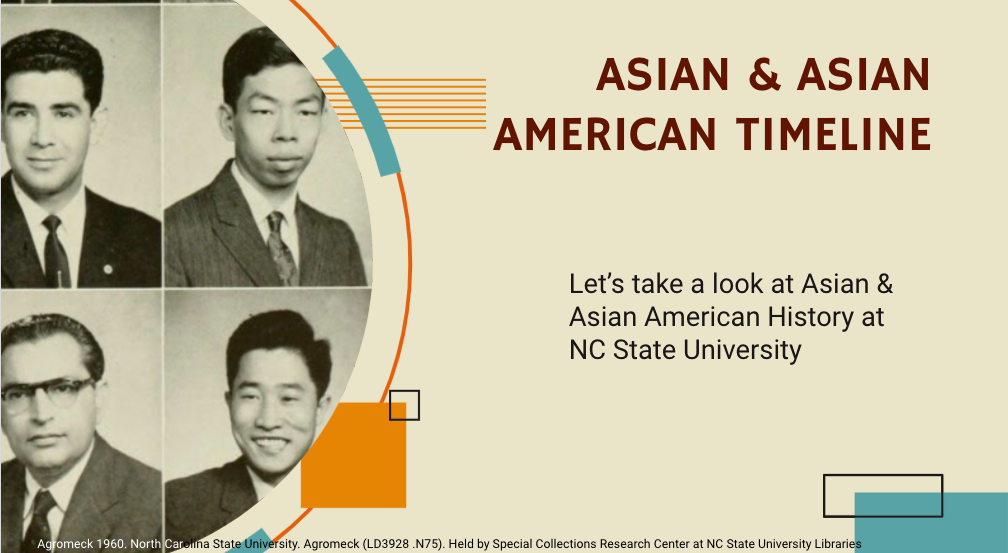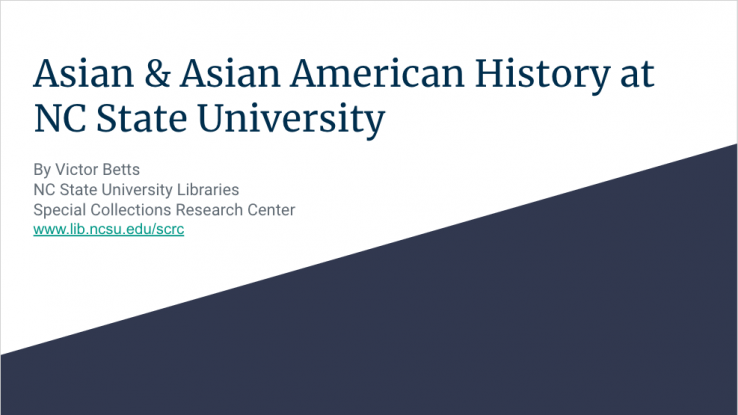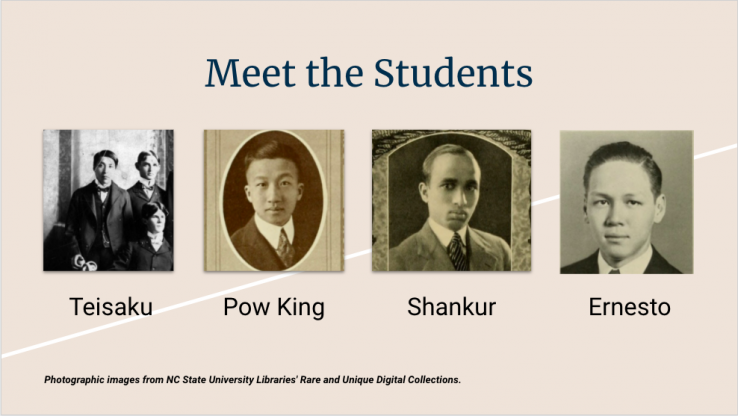
Asian & Asian American Timeline at NC State University

Asian & Asian American Timeline at NC State University
In "Stories from the Classroom," we’ll feature teaching partnerships and collaborations with the Special Collections Research Center from the perspective of the faculty and staff who led them.
In Fall 2019, as an NCSU Libraries Fellow working with outreach and teaching in the Special Collections Research Center, I first stepped into Mary Estrada's FLE 400: American English Pronunciation for International Students class to talk about archival materials pertaining to international students at NC State University. The information presented was part of archival research I was conducting for a new Asian and Asian American Historical State Timeline that was underway at the time.
Following that initial visit, Professor Estrada invited me to speak more about the history of international students at NC State to her classroom of international students in FLE 101: Academic Writing and Research for non-native speakers of English. She also wanted to use this opportunity to have her students somehow use creative writing to improve their English language skills so the students could write more freely and produce works that stepped away from more formal essays.
I used this opportunity to teach the class about the invisible history of international students at NC State, but also to make certain that the students learned about archives at large, how to access library and archival resources, and to critically think and contextualize how the history of race and immigration in the U.S. shaped the lives and experiences of the international students profiled in the presentation.

(Above image) Munir Ahmad Kahn High Voltage Laboratory, 1952.
Drawing from my experience working in academic and student affairs, I knew that a sense of belonging heavily impacts student success. International students, in particular, are likely to experience a heightened sense of isolation at the university, so I wanted them to walk away knowing that they were a part of a long and ongoing history of international students at the university and of other immigrants in the country. Learning about this particular history through University Archives presented the real possibility of making international students feel a sense of connection and belonging to the university, demonstrating that there is space and support for them despite any negative experience they may have faced.
I selected four international students documented in resources in the Special Collections Research Center’s Rare and Unique Digital Collections to profile along with other images and text for students to critically think about their own experience as international students. These primary sources provided historical context to the present day and an opportunity to imagine creatively about the future. Before diving into the creative writing portion of the class, I invited an open discussion with the international students by posing the following questions:
Who is telling the story that we are reading, seeing, or listening to? What point of view are we being exposed to as researchers? And what can we do as present day researchers about unknown or missing information in the archives?

(Above image) First Chinese graduates Pow King Chu, Tao Shen Foo, Shang Wu Jen, and William P.H. Hwang, 1922.
(Above image) Ernesto Ventura Santos, one of two Filipino students to graduate NC State in 1940. The other Filipino student was Luis Hidalgo Lim.
The university archives have historical records of international students from the 1920s. However, they do not contain records from the perspectives of the international students themselves. When contextualizing history and the historical record, it's important to think about voice because voices tell a unique story. With creative writing, especially when writing historical fiction in this particular instance, it's important to consider the construction of a story and how narratives are formed, while also understanding how power and positionality shape it. Writing about people who do not share your positionality or identity can be intruding, even damaging as further explained in acclaimed writer Alexander Chee’s article, “How to Unlearn Everything: When it comes to writing the ‘other,’ what questions are we not asking?”. Fortunately, this writing exercise intentionally involved international students writing about international students, or writing from the point of view of an international student, which they drew from their own lived experiences and shared identities.
The students chose one prompt from the following:
Both the instruction and writing exercise were a big success and I enjoyed teaching and engaging with the students about archives and invisible histories. The students learned many new things about themselves and their creativity and as an instructor, it was rewarding to see the students’ responses and learning outcomes. I created an asynchronous virtual version of the lesson as the university shifted to remote learning due to the COVID-19 pandemic in Summer 2020.
The Asian and Asian American Community timeline and the Latinx Community timeline are now available for research along with other timelines documenting the history of NC State University, which include African Americans, Native Americans, and many others. The Special Collections Research Center contains a growing collection which can be accessed by searching our digitized collections and online collection guides.
Learn more about how you can teach with Special Collections on our website. If you are interested in collaborating with the Special Collections Research Center to design a class session or assignment, please contact us at library_specialcollections@ncsu.edu or fill out our instruction request form.